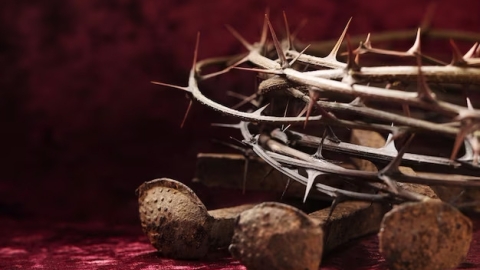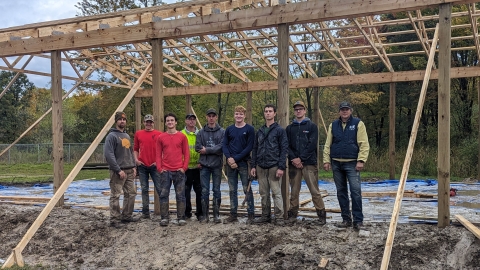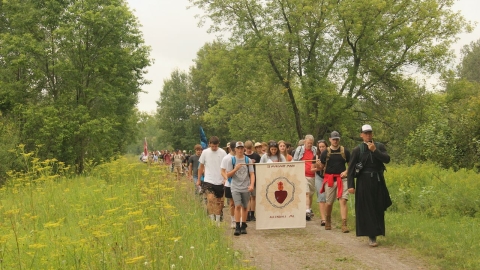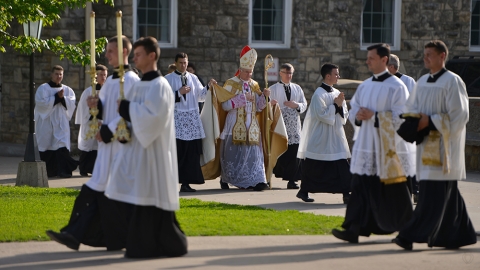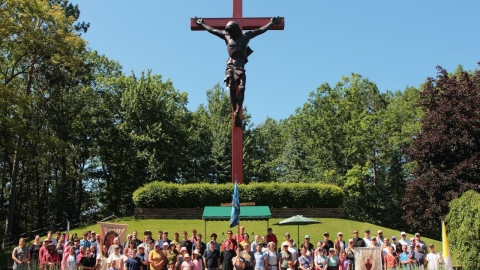The Search for the Martyr's Monument

Site of Teanaustaye and Martyrdom of St. Anthony Daniel S.J. - 4 July 1648
Arriving in Canada for the Martyrs’ Pilgrimage, Frs. Webber and Kimball went on a goose chase of a hunt. For what did they hunt? A site worth the search, a place where one of the North American Martyrs went to his death.
Some of these sites are known. Auriesville, NY is where three of the martyrs laid down their lives. The place where the Canadian Martyrs pilgrimage begins, St. Ignace II, is the site of the deaths of Sts. John de Brebeuf and Gabriel Lalemant.
Some of the other Jesuit saints are not so fortunate; the sites of their martydoms are unknown or little known. The latter is the case with St. Anthony Daniel. Fortunately, it is marked, but very few people know about it and thus very few visit and pray in that sacred place.
He died a beautiful death, Fr. Daniel. When the Iroquois attacked the mission in which he had just finished saying Mass, he advanced - still in his priestly vestments - towards the intruding foe. In the attempt to coerce them to flee, he was shot in the heart by an arrow and fell dead on the spot. The Iroquois warriors set fire to the church, and taking his lifeless body, threw it into the midst of the flames. God received the sacrificial burnt-offering of this brave martyr, consummated in the place where just moments before, the same priest had offered up the sacrifice of the Mass.
When Fr. Kimball researched the location of Teanaustaye, the Indian village where St. Anthony died, very little information turned up. Following a small lead from a blog, he received an approximate location from some former visitors of the place. When the priests visited the area, it took some time of going door to door and asking questions before the site was finally located.
A monument has been built in the place where the village of Teanaustaye stood. It was here that Fr. Daniel had founded the mission St. Joseph. It is located in the environs of Hillsdale, ON, in a place that overlooks a beautiful forested park. It was here that he generously gave his life for his flock and died for his faith.
Sadly, however, the monument is on private property, in a cow pasture. Although the owners did not object to our visiting this venerable place, it is difficult to know how many visitors they would tolerate coming onto their land. Someday, we should pray, it will be available for veneration by the general public.

Early morning Mass at St. Ignace II
Later on, early on Saturday morning, the two priests decided to say Mass at St. Ignace II, which is open to the public. It was to this mission that Sts. John de Brebeuf and Gabriel Lalemant were brought after their capture; it was in a large building that Brebeuf had destined to be the church that they were tortured for so many hours.
Below is an account of the torments and martyrdom of these two courageous saints.
One morning in March, 1649, the two priests were on their way to St. Ignace, staying the night at the St. Louis mission. An enormous band of Iroquois, mostly Senecas and Mohawks, surprised the Indians at St. Ignace and swept through the village, killing the vast majority of the inhabitants. They quickly sped on to St. Louis, where the inhabitants had been warned, and were briefly repulsed by the few Huron braves who had not fled. It was not long before they chopped their way through the palisades, overwhelmed the defenders, and spread death and destruction throughout the village. They fell upon the priests with fury, beat them and bound them, forcing them to join the other prisoners they had taken.
The prisoners were taken to St. Ignace, from which smoke was still rising. The priests were stripped and made to run the gauntlet. They were then led into a large cabin that Brebeuf had built, a building that was meant to be the mission church one day. It was here that the priests would consummate their final sacrifice. In this building were erected six torture posts, surrounded by the customary fires. The priests made to each other their final confessions and then spoke a few words of encouragement to the Huron prisoners.
Brebeuf was chosen first. The Iroquois were determined to break him, and the tortures they inflicted upon him were far more than a man could bear by his own strength. After mangling his hands, they dragged him to a post, which he embraced as Christ had His cross. They applied burning torches to his whole body. They couldn’t understand why he didn’t cry out and so they applied the fire as long as they could, and cut into the burned flesh with their knives. Brebeuf raised a strong voice to encourage the Indians, who were Christians:
"My sons, my brothers, let us lift up our eyes to Heaven in our affliction. Let us remember that God is the witness of our sufferings, that very soon He will be our exceedingly great reward. Let us die in our Faith. Let us hope from Him the fulfillment of His promises to us. I have more pity for you than I have for myself. Bear up with courage under the few torments remaining. The sufferings will end with our lives. The grandeur which follows them will never have an end."
His torturers could not believe his courage. The only words he spoke when his pain was great were, “Jesus, have mercy on us!” The tortured Hurons would repeat this after him. In their attemps to break this defiant bravery, the tormentors cut away his lower lip and thrust a red-hot iron down his throat. Still, he made no cry for mercy. They brought into the building Fr. Lalemant, in order that he might see his suffering confrere and warn him of what was to come; they tied him to one of the posts and set fire to the pitch-smeared bark that they had tied around him.
The Iroquois hung a string of six red-hot hatchet heads around his neck. Whichever way he moved his body, these hatchets burnt their way into his flesh. “Jesus, have mercy on us,” were the only words that left his mouth. Desperate in their attempts to break him down, they burnt some bark they had wrapped around his waist. An apostate Huron who was among his torturers invented a torture which was diabolical in its significance. He poured boiling water over the priest’s head, telling him that he wanted to help him, since only those who receive a good baptism can be happy in Heaven. When he didn’t recoil at this, they cut strips of flesh from his body and ate them in front of his eyes. The apostate Huron stabbed him repeatedly with a knife, telling him that by this too, he was doing him good, since the priest had told them that suffering on earth would make them happier in heaven.
The tortures continued, reaching unheard of depths of cruelty. The Indians cut off his nose, sliced off his upper lip, and cut out part of his tongue. His body began to sag, approaching death, and then the Indians gouged out his eyes. They then dragged him, just before death, to the torture platform, to perform the final rites in honor of their god of the hunt and of war, Areskoui. They cut off his feet, scalped him, and removed the heart from his body. According to their custom and in order to gain his strength, they consumed his heart and drank his blood. Thus died John de Brebeuf, a pinnacle of strength among his fellow martyrs.
Gabriel Lalemant was next. In order that he would live longer and give them longer sport, the Indians fed him a meal of cornmeal mush. As night fell the torments began: they beat him, crushed his hands and then tied him to the torture post. A slow fire was made to burn beneath him and they laughed when his feet danced. His only words were the same as Brebeuf’s: “Jesus, have mercy on us.” Being a much weaker, slighter man than Brebeuf, they were stupefied to see he shared his same strength.
At this point the Indians decided to moderate the torture. They wanted him to last the night so that he might become the morning sacrifice to their god Areskoui; Brebeuf had just been offered as the evening sacrifice. Therefore they continued to apply burning sticks and red-hot hatchets, but did so more slowly. Before allowing him to rest they gave him the mock baptism that Brebeuf had received. After a short period of reprieve, the Indians returned in the early hours of the morning. They forced burning sticks into his mouth, sliced off his tongue, put out his eyes and filled the sockets with burning coals. After chopping off his hands and cauterizing the stumps, they again rested. When they returned at dawn they found him still hanging on to life, and they made of him a second ritual sacrifice to Areskoui. They scalped him, took out his heart, and then gave the final blow to his skull with a tomahawk. He had been tortured, on and off, for fifteen hours, a happening likely unsurpassed in the bloody history of the Iroquois. The date was March 17, 1649, and the brave soul of Fr. Gabriel Lalemant sped on its way to join that of Brebeuf in the happy land of Heaven. Their bodies were recovered and we still have their relics among us.
This story is an abridged telling of the martyrdom of the martyrs found in Saints of the American Wilderness, an excellent book by John A. O'Brien.
